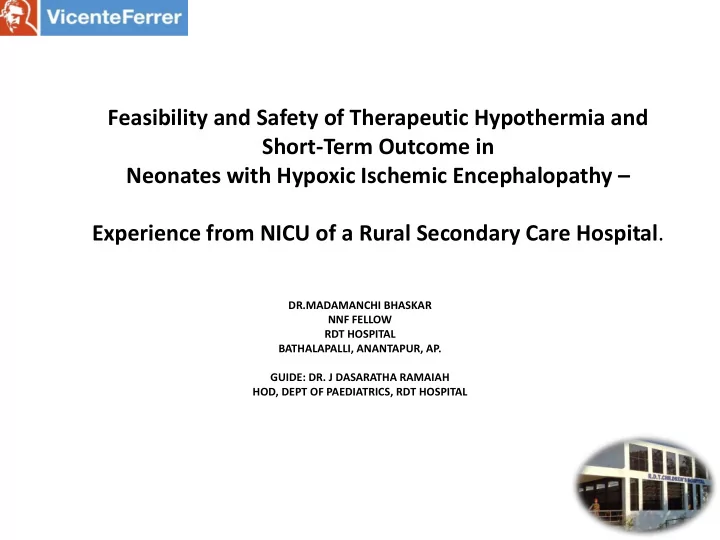

Feasibility and Safety of Therapeutic Hypothermia and Short-Term Outcome in Neonates with Hypoxic Ischemic Encephalopathy – Experience from NICU of a Rural Secondary Care Hospital . DR.MADAMANCHI BHASKAR NNF FELLOW RDT HOSPITAL BATHALAPALLI, ANANTAPUR, AP. GUIDE: DR. J DASARATHA RAMAIAH HOD, DEPT OF PAEDIATRICS, RDT HOSPITAL
INTRODUCTION • Neonatal encephalopathy following perinatal asphyxia in neonates is still a common and serious condition 1 . • Infants with moderate-to-severe neonatal encephalopathy carry a high risk of adverse outcome, such as mortality, cerebral palsy, neuro developmental impairment 2 . • Various Published studies indicate that Therapeutic Hypothermia (TH) for Hypoxic Ischemic Encephalopathy increase survival without neurological sequelae. • However, it is not the standard of care in many neonatal intensive care units (NICUs) in India.
AIM &OBJECTIVE • Aim: To assess the feasibility, safety, and effectiveness of TH in a rural secondary care Hospital. • Objective: To determine the characteristics of the newborns kept on TH, birth conditions, features of body temperature control, clinical complications, adverse events, and outcome .
MATERIALS & METHODS • Place of the study: NICU of Rural Development Trust Hospital, Bathalapalli, Anantapur, Andhra Pradesh. • Study Design: Retrospective Observational Study • Study period: July1, 2018 to July 31, 2019 (13 months) • Inclusion criteria: Newborns with moderate to severe birth asphyxia according to modified Sarnat staging 3 who had been treated with TH.
METHODOLOGY • Target temperature (33.5 0 C) was achieved by using phase changing material- based device – (Mira Cradle- Neonate Cooler) which was developed by Pluss Advanced Technologies Pvt.Ltd in collaboration with CMC Vellore. • The newborns were monitored and managed as per predesigned unit protocol. • The data collection (from the hospital records) include: perinatal characteristics of newborns blood gas within first hour of life severity of encephalopathy, time to start TH time to reach target temperature (33.5 0 C) adverse events during hospital stay outcome • Fidgety Movements were assessed at 9 to 15 weeks of age
STASTICAL ANALYSIS • We Performed descriptive analysis on the data. • Qualitative variables are expressed as absolute and relative frequencies. • Numerical variables are expressed as mean, median, minimum and maximum values.
RESULTS Perinatal Characteristics Categorical Variables Absolute Frequency Percentage Sex - Male 34 61.8 % Female 21 38.2 % MOD- NVD 23 41.8 % Assisted VD 12 21.8 % LSCS 20 36.3 % Place of Delivery: In Hospital 44 80 % Extramural 11 20 % Encephalopathy at admission- Moderate 42 76.3 % Severe 13 23.6 %
RESULTS Numerical Variables • APGAR score at 5 minutes: Median Minimum Maximum 5 3 7 • 1 st Hour Blood Gas : Mean Minimum Maximum pH 7.15 6.87 7.31 BE - 12.64 - 25.4 -1.2
FEASIBILITY MEASURE • For all babies, TH was initiated within 6 hours of life. • Mean age at initiation of TH is 2 hours 40 minutes. • Mean time of achievement of target temperature is 1 hour 40 minutes. • Cooling was discontinued before 72 hours 4 (7.2 %) babies due to severe refractory shock and coagulopathy (3) and moribund encephalopathy (1). • The mean duration of rewarming after TH was 13 hours 20 minutes with rate of rewarming 0.22 0 C/ hr.
SAFETY MEASURE(ADVERSE EVENTS) 40 35 30 25 20 15 10 5 0
OUTCOME DIED(10.9% ) LAMA(10.9% ) Discharged (43) LAMA(6) Died(6) DISCHARGED (78%) All discharged babies were on breastfeeds and 6(13.9%) babies were on anticonvulsants at the time of discharge
FIDGETY MOVEMENTS (9-15 WEEKS OF AGE) Abnormal Fidgety Movements 7 (20%) NormalFidgety Movements Normal Fidgety Movements 28 ( 80%) Abnormal Fidgety movements
DISCUSSION • In this study we observed that TH can be practiced in Rural secondary hospital NICUs with well defined protocol. • Time taken to reach target temperature(33.5 0 C) in study is 100 minutes which is lower than a Published multi centric Indian Study 4 ( 120 min) but more than NICHD Trail 5 (90 min) which used servo-controlled equipment. • The temperature fluctuations above upper limit(33.8 o C )were similar (6.9% vs 5.7) , but the fluctuations below lower limit(33.2 0 C) were significantly lower (2% vs 5.1) when compared to study by Thomas N 4 et al.
DISCUSSION Rewarming rate is slow (0.22 0 C/hr) when compared to the multi centric • study 4 (0.28 0 C/hr). • The adverse events in our study were comparable to Thomas N 4 et al study.
LIMITATIONS • There is no control group • Long term follow up of the babies is needed.
CONCLUSION • TH is a safe and effective intervention and can be practiced in secondary care hospital NICUs • Prerequisites for practice of TH as a standard of care in secondary care hospital NICUS are: Neonate whole body cooler Established Protocol Bedside 2D Echo Training of Staff Expertise to secure and aseptically maintain Umbilical venous catheter
REFERENCES 1. Hakobyan M, Dijikman K,Laroche S,Naulaers G, Rijken M, Steiner K et al. Outcome of Infants with Therapeutic Hypothermia after Perinatal asphyxia and Early onset sepsis.Neonatology.2018;115(2):127-133. 2. Pin TW, Eldridge B, Galea MP. A review of developmental outcomes of Term infants with post- asphyxia neonatal encephalopathy. European Journal of Pediatric Neurology.2009; 13(3):224-34. 3. Sarnat HB, Sarnat MS.Neonatal encephalopathy following fetal distress. A clinical and Electroencephalographic study. Arch Neurol.1976;83:696-705. 4. Thomas N, Abiramalatha T, Bhat V, Varanattu M, Rao S, Wazir S et al. Phase Changing Material for Therapeutic Hypothermia in Neonates with Hypoxic ischemic Encephalopathy- A Multi-centric study. Indian Paediatrics.2017; 55(3)201-205. 5. Shankaran S, Natarajan G,Chalak L,Pappas A,Mc Donald S,Laptook A. Hypothermia for Neonatal Hypoxic ischemic Encephalopathy: NICHD Neonatal Research Network Contribution to the field. Seminars in Perinatology.2016;40(6):385-390.
THANK YOU
Recommend
More recommend